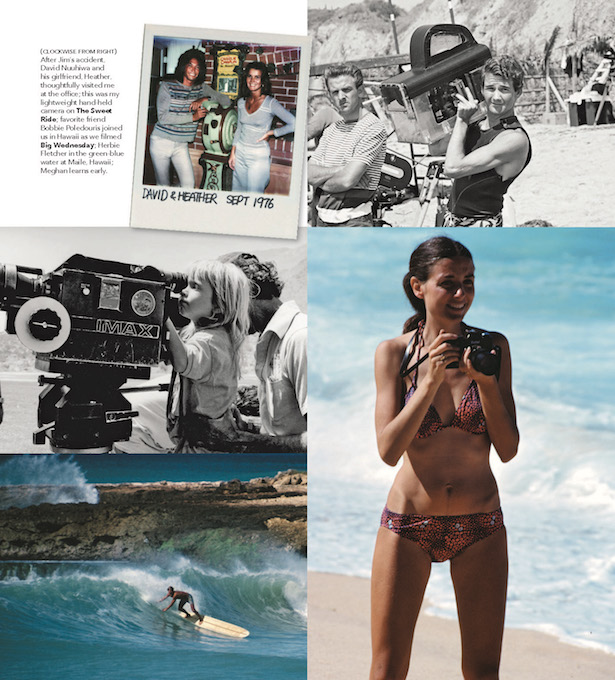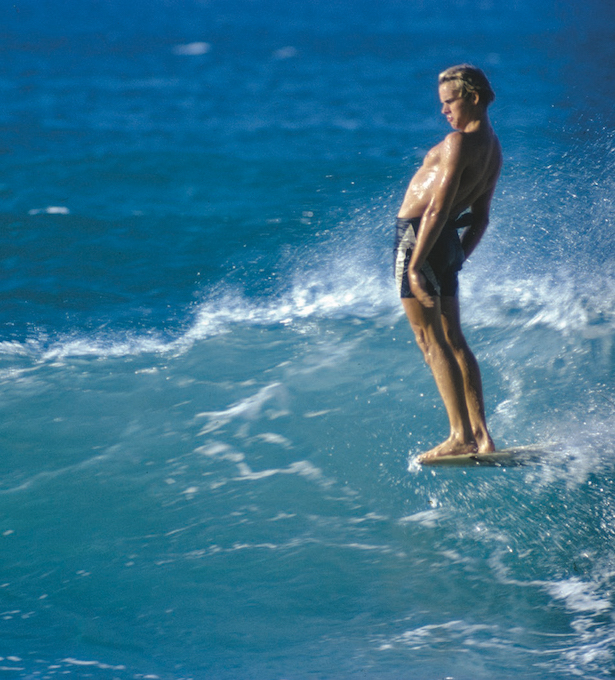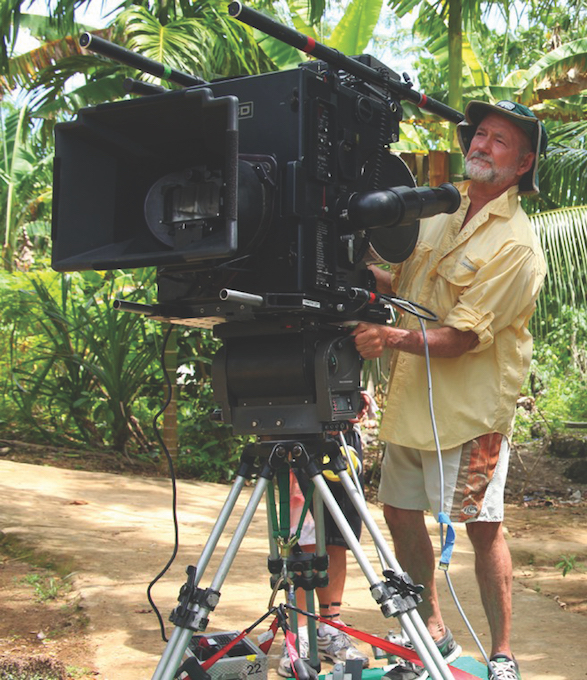
Laguna Beach filmmaker Greg MacGillivray celebrates the 50th anniversary of his classic surf film, “Five Summer Stories.”
By Christopher Trela
Before Laguna Beach resident Greg MacGillivray was nominated for Academy Awards for his Imax films “Dolphins” and “The Living Sea,” before he managed to haul a huge, heavy camera up an icy mountain slope to film scenes for the Imax film “Everest,” before he went to Hollywood and worked on such films as Stanley Kubrick’s “The Shining,” surf culture ruled his life.
Growing up in Corona del Mar, MacGillivray started surfing at a young age. His parents gave him an 8 mm movie camera for his 13th birthday, and he began to shoot footage of his friends as they rode the waves.
According to MacGillivray, he’d borrow a projector, gather friends together, charge them 25 cents admission to his parents’ garage, and show about 40 minutes of films. A couple dozen people would show up. “Their encouragement inspired me to work harder for the next screening, and gradually I started to make better and better films,” he says.
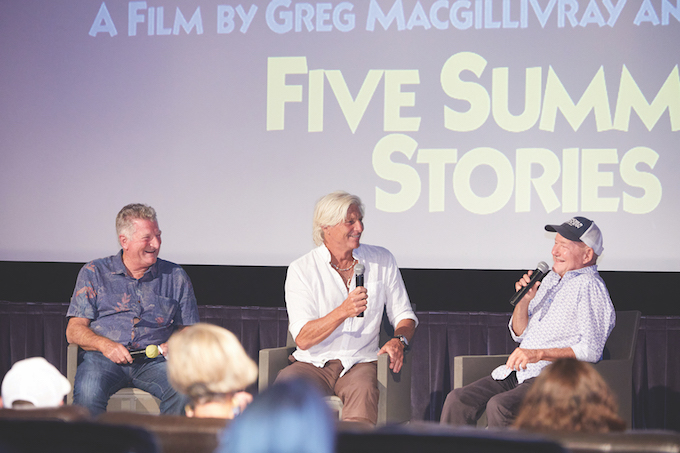
In fact, his films got so much better that he and longtime friend Jim Freeman eventually formed MacGillivray Freeman Films in 1963. They moved into a historic building in north Laguna called Pyne Castle, which had space for an editing room, camera storage, offices, a bedroom and even a large living room where they could project movies.
The duo began shooting 16 mm surfing films, which portrayed the surf culture in cinematic time capsules, culminating in 1972 with their final surf movie, “Five Summer Stories,” widely acknowledged as the best surf film of all time. The film captured the joy of surfing, with a backdrop of the political and environmental issues of the time, plus a notable soundtrack by The Beach Boys and Honk.
A Storied Celebration
Fast-forward a half century and MacGillivray Freeman Films has released a special 50th anniversary version of “Five Summer Stories,” which premiered in August at the New Port Theater in Corona del Mar, followed by screenings around the country.
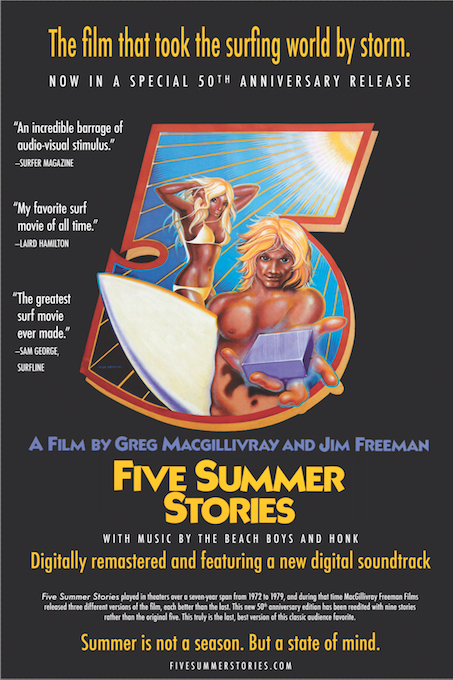
Locally, “Five Summer Stories” will be featured at this year’s Coast Film & Music Festival in Laguna Beach. In addition to a Nov. 9 screening of the film at 7 p.m. at Hobie Surf Shop, there will be another screening on the night of Nov. 13 at the Festival of Arts grounds as part of the Laguna Legends Filmmaker Showcase; the latter event will also feature a performance by Honk, one of the bands that created music in the film. Following the performance, MacGillivray and Honk band members Steve and Beth Wood, Tris Imboden, Richard Stekol and Craig Buhler will participate in a Q&A on the making of the film and inspiration for the music that became a cultural touch point. MacGillivray will also be signing copies of his new visual memoir, “Five Hundred Summer Stories: A Life in Imax,” which will be available at bookstores including Laguna Beach Books and online beginning Nov. 15.
Also, “Five Summer Stories: The Exhibition” will be featured Nov. 4 through March 7 at Laguna Art Museum as part of the institution’s Art & Nature programming, which begins Nov. 3. Deemed by many as the most important surf movie ever made, the exhibit will showcase original artifacts depicting how the film was created as well as surfboards, film footage and ephemera from the theatrical release that drew record crowds.
Looking Back
Sam George, former senior editor at Surfing Magazine, recalls seeing “Five Summer Stories” for the first time in the early 1970s and notes that he and others in the audience had no idea what they were about to witness.
“We had seen plenty of surfing movies—they were crudely filmed, no theme at all [and] the music was whatever they had on their eight tracks,” he shares. “We assumed we were going to see another surf movie, so you can imagine how stunned we were when ‘Five Summer Stories’ came alive on the screen. It was like nothing we had ever seen before. The quality of the cinematography, the music that was written for the film—it was nothing we had seen.”
George says the film presented a perspective of what surfing was at the time and what it could be.
“It was a hugely effective film and changed the perspective of the surfers who watched it,” George says. “If you look at the quality and audacity, ‘Five Summer Stories’ would have to be the greatest surf movie ever made.”
For their initial screening of “Five Summer Stories” in 1972, MacGillivray and Freeman rented the Santa Monica Civic Auditorium, which held 3,000 people.
“The film was shown in stereo through the best sound system you could get at that time,” MacGillivray says. “The magnetic film carried the soundtrack, separate from the film, so there were two machines—one running the film, the other running the soundtrack. Both had to be in sync with each other. We’d bring in our own speakers, gigantic rock ’n’ roll speakers, and a gigantic amplifier. It was like a rock concert. If you saw the film in one of its first 10 runs in SoCal, you were treated to this stereo sound that was magnificent. And you have music by Honk and The Beach Boys. We were able to showcase that wonderful music with this great sound system and give kids an experience they hadn’t had at a surf movie, ever. It was truly mind-blowing. For an hour and a half, you are just taken away. It was one of those transformative experiences that I’ll always remember.”
A writer from Rolling Stone magazine interviewed MacGillivray during that initial screening, and said in her review that MacGillivray seemed like an algebra teacher.
“I still seem like an algebra teacher,” MacGillivray laughs. “I was a math major in college, and Jim was pre-med. Our hobby was filmmaking. Actually, 90% of our life was filmmaking, which is why the 12 years we spent together before Jim was killed [in a helicopter crash in 1976] was such a seminal experience for me. We learned from each other and pushed each other every day.”
MacGillivray proudly notes that he and Freeman never got a loan to make their movies—and never borrowed from their parents either. They paid off their films before they showed them. MacGillivray’s advice to aspiring filmmakers: “If you have a good idea and you believe in it, just follow your idea and don’t listen to other people. They are going to misguide you. That’s what Jim and I believed.”
Although Freeman died nearly 50 years ago, MacGillivray has honored his late partner by keeping the company’s name MacGillivray Freeman Films. MacGillivray has produced and directed more than 50 films; nearly 40 of them are in the Imax format. And he initiated the development of three cameras for the Imax format: the high-speed (slow-motion) camera, the industry’s first lightweight camera, and the all-weather camera used during filming on Mount Everest.
Laguna Life
Greg, his wife Barbara, and their two children are all involved with MacGillivray Freeman Films, which is still based in Laguna Beach. In fact, the couple have lived at the same home in Laguna for 50 years.
“It’s a surf spot at Thalia Street,” MacGillivray says. ”Barbara and I were walking down the beach after I had gone surfing, and saw a five-unit apartment building for sale. I talked to the owners and they were kind of desperate to sell, so I got a good price. We moved into the bottom unit closest to the ocean so I could run out and surf almost any time I wanted, and we rented out the other four units. The rent paid our mortgage. We totally lucked out.
“It was also a great place to raise kids. Their buddies kept their surfboards at our house so every afternoon there would be 10 kids there. Barbara kept the refrigerator stocked with healthy drinks and food. Never a dull moment.”
And even in his late 70s, there is still never a dull moment for MacGillivray. He’s finishing a film project for an amusement park in Abu Dhabi as well as directing an Imax film on the cities of the future and another about the marvels of medicine.
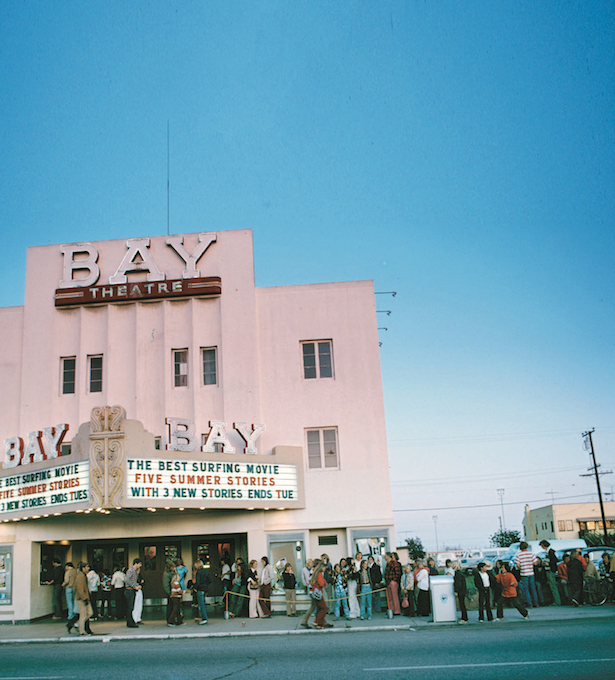
But does he still find time to surf?
“Every once in a while,” he admits. “My body is not as supple as it used to be. I did so much athletic stuff as a kid that now I have a bad shoulder and bad knees. My pop-up on my surfboard is not a pop-up anymore—it’s like a crawl-up. But I still love the water—you’ll never get me out of the water.”
Surfing temporarily took a back seat to writing, so MacGillivray is happy that his book “Five Hundred Summer Stories” is about to be released. MacGillivray said instead of sitting down to write the stories that make up the book, he dictated the stories into his cell phone as he walked along the beach in Laguna.
“It was a fun process. I really enjoyed it,” he says.
The book highlights not only the making of “Five Summer Stories,” but his own stories of growing up in Newport Beach and spending time in Laguna Beach, the challenges he faced as a young filmmaker, and the increased challenges—and successes—of making Imax films.
The book contains anecdotes and insights into his career plus myriad photos, along with 40 QR codes that, when scanned, take readers to additional never-before-seen footage that highlight the stories MacGillivray is sharing.
“Hopefully when people come to a QR code, it fits into the storytelling and you get the feeling of being there,” MacGillivray says. “I think it will add a lot to the overall enjoyment of the book.”
+ To find out more about MacGillivray Freeman Films, visit macgillivrayfreeman.com. For more information on the movie “Five Summer Stories” and to watch a trailer, go online to fivesummerstories.com.
Photos by MacGillivray Freeman Films


